Pacer (British Rail)
Pacer is the operational name of the British Rail Classes 140, 141, 142, 143 and 144 diesel multiple unit railbuses, built between 1980 and 1987. The railbuses were intended as a short-term solution to a shortage of rolling stock, with a lifespan of no more than 20 years.
| Pacer | |
|---|---|
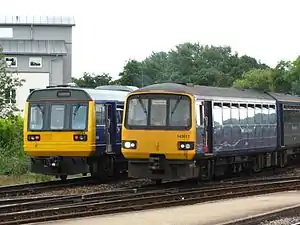 | |
| In service | 1984– present (production units) |
| Family name | Pacer |
| Constructed | 1980–1987 |
| Number built | 165 sets |
| Number in service | 15 sets (National Rail) |
| Number scrapped | 37 sets (142/143/144) |
| Operator(s) | |
| Specifications | |
| Coupling system | BSI |
| Track gauge | 4 ft 8 1⁄2 in (1,435 mm) standard gauge |
All Pacer trains were scheduled to be retired by the end of 2019 as the Rail Vehicle Accessibility Regulations require that all public passenger trains must be accessible to disabled people by 2020 - however the Pacer units were given dispensation until the end of 2020. Only one Pacer (the modernised 144e) currently meets this requirement, and the remainder were therefore planned to be withdrawn by that date. Furthermore, a decision in 2015 by the Transport Secretary required that such railbuses be removed from service by 2020 for the then-new Northern franchise, stating that the "continued use of these uncomfortable and low-quality vehicles is not compatible with our vision for economic growth and prosperity in the north".[1]
At the start of 2020, 138 Pacer units were either still in service or storage with three National Rail operators: Northern Trains, Great Western Railway and Transport for Wales.[2] Northern Trains retired its last Pacer unit on 27 November 2020,[3] with Great Western Railway following in December 2020.[4] Transport for Wales expect to operate their Class 143s into the first part of 2021.
Features
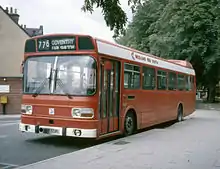
The Pacer series were built with low construction and running costs in mind, and so all of the Pacer units use:[5][6]
- A lightweight modified bus body and other bus components, such as seating, with a reinforced driver's cab area to comply with crashworthiness standards.
- A long-wheelbase four-wheel freight-wagon-inspired underframe, rather than the conventional arrangement of two four-wheeled bogies. This arrangement has been criticised for rough-riding, and causing loud noise and excessive wear to the wheels and track on tight curves.
Background
By the beginning of the 1980s, British Rail (BR) operated a large fleet of first generation DMUs, which had been constructed in prior decades to various designs.[7] While formulating its long term strategy for this sector of its operations, British Rail planners recognised that there would be considerable costs incurred by undertaking refurbishment programmes necessary for the continued use of these aging multiple units, particularly due to the necessity of handling and removing hazardous materials such as asbestos. In light of the high costs involved in retention, planners examined the prospects for the development and introduction of a new generation of DMUs to succeed the first generation.[8]
In the concept stage, two separate approaches were devised, one involving a so-called railbus that prioritised the minimisation of both initial (procurement) and ongoing (maintenance & operational) costs, while the second was a more substantial DMU that could deliver superior performance than the existing fleet, particularly when it came to long distance services.[8] While the more ambitious latter requirement would ultimately lead to the development of the British Rail Class 151 and the wider Sprinter family of DMUs, BR officials recognised that a cheaper unit was desirable for service on the smaller branch lines that would not be unduly impacted by lower performance specs or a high density configuration. As such, work to progress both approaches was undertaken by BR's research department during the early 1980s.[8]
During this period, a number of prototypes were constructed to explore different designs and approaches for implementing the railbus concept. The initial prototype, known as LEV 1, was a joint project by the British Rail Research Division and Leyland Motors and used a bus body mounted on modified freight vehicle underframe (HSFV1). A subsequent test vehicle, a single two-car unit, designated as the Class 140, was constructed between 1979 and 1981.[9] The principal difference between the Class 140 and the preceding R3 concept was the incorporation of the underframe structure into the body above, thus making the latter a load-bearing structure.[8] Other changes included the strengthening of the cant rail area and the use of standard BR multiple unit ends, enabling compliance with full Union Internationale des Chemins de fer (UIC) end load specifications for multiple units.[8] Internally, a mixture of standard railway multiple unit seating and bus seating was installed. The resulting railbus was relatively lightweight, as had been desired by BR's concept.[8]
The Pacers had originally originally intended as a low-cost stopgap solution to the rolling stock shortage, with a maximum lifespan of 20 years.[5][10] A total of 165 Pacer trains (totalling 340 carriages) were built for BR. By 2015, the majority of these remained in operation with various private train operating companies, despite the type being in excess of 30 years old. Outside of the UK, Pacer demonstrator units toured various nations, including the U.S., Northern Ireland, Belgium, Sweden, Thailand, Malaysia and Indonesia, without producing significant sales. However ,Iran purchased redundant Class 141 units, for use on suburban lines around Tehran until 2005.[10]
Class 140
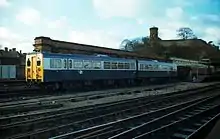
The Pacer series was the result of an experiment to assess the viability of using bus parts to create a diesel multiple unit. The two-car Class 140 was a prototype vehicle that was built in 1980 at British Rail Engineering Limited (BREL)'s Derby Litchurch Lane Works. This prototype was introduced with much fanfare during June 1981.[9] During its trial period, the Class 140 toured various lines across the UK. It later functioned as a demonstration unit for the incoming fleet based on the type, the Class 141.[9] By 1985, the unit was in use as a driver training vehicle.[9] From September 1986, the sole Class 140 was allocated to Neville Hill.[11]
Initial testing with the Class 140 uncovered several issues, such as difficulty detecting the type via track circuits, this was reliably resolved by swapping the material of the brake blocks from a composite to iron.[8] Two less easily-addressable drawbacks were the high level of noise generated during transit, particularly on older jointed rails, which was a consequence of the railbus's direct connection between the underframe and suspension with the body that transmitted impact forces across the body. It was also observed that the inclusion of strengthening members in the mass-produced bus body added significantly to the overall production cost, which eliminated much of the cost advantage that was the primarily goal of the type.[8] The original traction power train of the Class 140 consisted of a Leyland TL11 200 HP engine, a Self-Changing Gears mechanical automatic gearbox and a Gmeinder final drive unit on each car driving only a single axle.[12] This propulsion arrangement was in part taken from the Leyland National bus. The controller for the automatic transmission was observed by BR engineers to the cause of numerous operating failures and other reliability issues; this was allegedly due to defective relay logic and poor earthing.[8]
Class 141
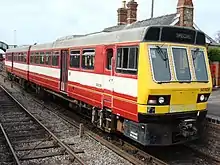
The Class 140 was viewed to be an overall success, and thus BR issued an order for an initial production model, designated Class 141, to British Leyland during 1984 with production commencing thereafter.[8] During its early years of service, the Class 141 experienced numerous issues, particularly with the transmission and ride quality; work undertaken at BR's direct resulted in the quick development of numerous improvements to at least partially address these shortcomings. When it came to ordering more railbuses, however, it was decided that instead of placing these follow-on orders for further Class 141, it would be more desirable to procure improved derivatives of the Class 141.[8] Accordingly, BR placed orders for two new models of the Pacer family with separate manufacturers, these being the Class 142 and Class 143 respectively.[8]
The prototype was joined by another 20 two-car units which formed the Class 141 fleet. The units were used mainly in Yorkshire, operating on predominantly suburban services. They had a capacity of 94 passengers per two-car set, and two Leyland TL11 engines gave a total of 410 bhp (310 kW), resulting in a top speed of 75 miles per hour (121 km/h). The Class 141s were built with standard Leyland National bodies, whose comparatively narrow width meant they could only be fitted with standard bus seating. The later Pacers had widened body panels to allow increased seating. Furthermore, in order to maximum cost savings, the manufacturers made use of road bus-standard electrical equipment, passenger fittings, and general cab layout wherever possible.[8]
During 1988, in response to reliability problems related to the electronics used, the entire class was briefly withdrawn and underwent a technical upgrade in 1988 at the Hunslet-Barclay works in Kilmarnock. The reliability issue was largely resolved via the replacement of the original relay-based controller of the transmission with an alternative that was microprocessor-based.[8] The units were permanently withdrawn from British Rail service in 1997. Many Class 14s were sold to Islamic Republic of Iran Railways.[10]
Class 142
.jpg.webp)
The next and largest Pacer class was the Class 142. As BR was considering ordering more railbuses, it was decided that, instead of placing these follow-on orders for further Class 141 vehicles, it would be more desirable to procure improved derivatives of the Class 141.[8] Accordingly, BR placed orders for two new models of the Pacer family with separate manufacturers, these being the Class 142 and Class 143 respectively.[8]
The Class 142 again was built by Leyland and BREL, in 1985. The body was based on a Leyland National bus, built at Workington in Cumbria. Many fixtures and fittings of the Leyland National could be found on the units. The new class had a greater capacity of 120 passengers per two-car set and the same engines were used. The first sets were used initially on Devon and Cornwall branch lines and on commuter services in the north west. The units from Cornwall were eventually moved to Liverpool and the north east, and the Class 142s became a common sight on services across the north of England.
The Class 142s received substantial upgrades during the early 1990s, which included the installation of more powerful Cummins engines, which gave a total power output of 460 bhp (340 kW) per two-car set. A number of units were then modified for use on the Merseyside PTE City Line on Merseyrail in the Liverpool region, which included dot-matrix route indicators, improved seating and Merseyrail PTE paintwork.
The Class 142s moved into the control of Arriva Trains Northern and First North Western at privatisation, and subsequently passed on to Northern Rail, Arriva Rail North, Northern Trains, Arriva Trains Wales and Transport for Wales. Eight Northern Rail units were temporarily withdrawn from service, replaced by a cascading of British Rail Class 158s.[13] First Great Western received 12 units on loan from Northern Rail from December 2007 to November 2011 (five units were returned to Northern in December 2008) to cover for refurbishment of its fleet and to allow most of its Class 158 fleet to be rebuilt as three-car sets.
Class 143 and Class 144
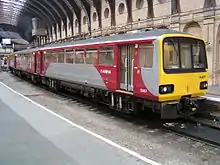
Around the same time of the Class 142 development, a Pacer railbus was being developed by Kilmarnock based Hunslet-Barclay. The units used a Walter Alexander bus body. The units were given the number Class 143 and entered service in 1985. Again with two 205 bhp engines giving a total output of 410 bhp (310 kW) and a top speed of 75 mph (121 km/h), the class originally had a capacity of 122 passengers. The class was used in the North East before being transferred to Wales and the South West, and were moved over to Valley Lines and Wales & West control during privatisation. They then passed on to Arriva Trains Wales, Wessex Trains, First Great Western and Transport for Wales. The interiors were completely changed in 2000, when the Valley Lines service was introduced, with full back, coach-type seating installed throughout, along with improved fittings. This reduced seating capacity to 106 seats per set.
It was followed by the similar Class 144, comprising a Walter Alexander body on BREL underframe, which was introduced in 1987. The most substantial design change was the replacement of the Leyland-built engine with a more powerful Cummins LTA10-R counterpart,[14][15] as well as the original mechanical transmission being substituted for a Voith hydraulic unit.[16][17] A Class 144 unit was formed of either a two-car set with 122 seats or a three-car set with a total capacity of 195 passengers and 690 bhp (510 kW), though still limited to 75 mph (121 km/h). The units were used in the North East, passing to Northern Spirit at privatisation, then to Arriva Trains Northern, Northern Rail, Arriva Rail North and now Northern Trains.
Advantages and disadvantages
Disadvantages
The Pacers have often been criticised as being of poor quality. Instead of the usual bogies, Pacers use a basic four-wheel two-axle configuration which often results in a ride which is noisier and less comfortable than other trains. The lack of articulation can result in a rough ride, especially over points, and a loud squealing noise around tight curves. The lack of bogies also results in a more basic suspension, which can result in a bumpier ride; this has given rise to the nickname "nodding donkeys" owing to the trains' up-and-down motion on uneven track. The basic bench seating can also be uncomfortable.[5] The early units, especially the Class 141s, were also especially unreliable.[10]
The fact that Pacers have only been used in certain areas of the north and south west of England and the south of Wales, but not London or south east England, has also created resentment.[5][10]
Concerns were raised about safety after the 1999 Winsford crash,[18] which involved a First North Western Class 142 Pacer running as empty stock was run into by a Virgin Trains Class 87 express after the Pacer unit had fouled the main line at Winsford, Cheshire on the West Coast Main Line.[19] The body of the Pacer was severed from its frame, to which it was attached by wire straps, causing severe internal damage; the unit was written off. Twenty-seven passengers and crew were injured, four seriously. However, all passenger injuries were on the other train, as the Class 142 was running empty at the time.[20]
Advantages
On the other hand, the Pacers have been praised as a pragmatic solution at a time when budgets were tight, and have been credited with saving services on some rural lines which might otherwise have been withdrawn had only more expensive rolling stock been available.[5] They have also proved economic to operate, achieving a fuel economy of 10 miles to the gallon.[10]
Replacements
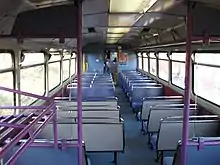
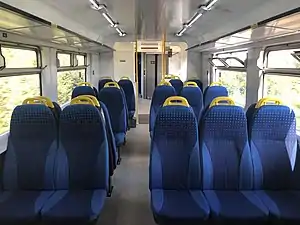
As of 2020, the oldest Pacers on the national network were appoaching 35 years old. All were planned to be withdrawn and scrapped by December 2019 as they do not comply with Rail Vehicle Accessibility Regulations.
CAF Civity
In July 2019, rollout of Northern's Class 195 CAF Civity units had begun on certain routes, which will allow refurbished Sprinters no longer needed on those routes to be used to replace Pacers instead.
Vivarail D-Train
These units are built out of upcycled London Underground D78 Stock, constructed between 1978 and 1981, which were in service on the District line until 2017. Conversion of the old stock to mainline railway use will involve re-using the aluminium bodyshells, traction motors and bogies from the D78 units and fitting them out with new diesel engines and interiors. The D-Train units underwent acceptance testing in 2015 and Vivarail pitched them to train operating companies (TOCs), especially those bidding for the Northern franchise.[21] While no orders were received from Northern, Transport for Wales will replace its Pacers with a combination of five D-Trains and rolling stock cascaded from other train operators,[22] and other TOCs have ordered D-trains to replace other outdated rolling stock: South Western Railway for the Isle of Wight's Island Line,[23] and West Midlands Trains for the Marston Vale line.[24]
"144e Evolution"
The Class 144e (Evolution) was a proposed refurbished variant of the Class 144 which would bring it up to the requirements of the Persons with reduced mobility-Technical Specifications for Interoperability accessibility regulations.[25] The demonstrator Class 144e unit (144012) featured a number of upgrades such as the addition of new 2+2 style seating, a fully accessible toilet, two wheelchair spaces and spaces for bicycles and luggage,[25][26] as well as Wi-Fi and media screens.[25] Porterbrook, which owns the Class 143 and Class 144 fleets, refurbished 144012 in 2014 to comply with the new legislation so that it could act as a demonstration unit.[27][28] The demonstrator unit was expected to re-enter traffic in April 2015,[29] but this was delayed until later in the year.[25]
Preservation
Several Pacers have been preserved for further use on heritage railways. The National Railway Museum has preserved 142001.[30]
In May 2019, the government called for a public consultation on re-using the trains after withdrawal from service; suggestions have included re-using them as public spaces, such as village halls or cafes.[31]
References
- Topham, Gwyn (27 February 2015). "New trains to replace north of England's ageing rolling stock by 2020". The Guardian. Retrieved 15 January 2021.
- "Pacers to continue into 2020, operators confirm". Railway Gazette. DVV Media Group. 22 October 2019. Retrieved 15 January 2021.
- Slater, Chris (27 November 2020). "Final call for hated pacer trains as last Northern 'truck on tracks' makes final journey". Manchester Evening News. Reach plc. Retrieved 15 January 2021.
- "2+3 HSTs help oust GWR Pacers". Modern Railways. January 2021. p. 103.
- Kelly, Jon (7 March 2016). "Pacers: The train that the UK has struggled to get rid of". BBC News Magazine. Retrieved 15 January 2021.
- Humble, Mike (13 January 2012). "Rail Projects : The BRE-Leyland Pacers – the dream becomes a nightmare". AROnline. Retrieved 15 January 2021.
- St John Thomas, David; Whitehouse, Patrick (1990). BR in the Eighties. Newton Abbot: David & Charles. ISBN 0-7153-9854-7.
- Shore, A. G. L. (1987). "British Rail diesel multiple unit replacement programme". CiteSeerX 10.1.1.1008.3291. Archived from the original on 28 November 2020. Retrieved 27 November 2020. Cite journal requires
|journal=(help) - Smith 2002, p. 3
- Bradley, Simon (17 October 2015). "Will Pacer trains trundle into history at last?". The Yorkshire Post. JPIMedia. Archived from the original on 15 December 2017. Retrieved 15 January 2021.
- Knight, Steve (November 1986). "Class 140 moves to Eastern Region". Rail Enthusiast. No. 62. EMAP National Publications. p. 30. ISSN 0262-561X. OCLC 49957965.
- Smith 2002, p. 7
- "Angel Trains leases 30 Class 158 diesel multiple units to Northern Rail" (PDF). Northern Rail. 13 March 2007.
- Diesel Multiple Units 2010. Platform 5. 2010. p. 15. ISBN 978-1-902336-75-6.
- Vehicle Diagram Book No. 220 for Diesel Multiple Unit Trains (Railcars) (PDF). Barrowmore MRG. Derby: British Railways Board. 1982. DP240, DP241, DR205. Archived (PDF) from the original on 21 January 2015. Retrieved 18 February 2016.
- Fox 1987, p. 42
- "Pacers: the unlikely local heroes…". railmagazine.com. 12 August 2019. Archived from the original on 21 September 2020. Retrieved 28 November 2020.
- "Safety fears over commuter trains". BBC News. 2 July 1999. Retrieved 15 January 2021.
- "Train driver averts disaster". BBC News. 23 June 1999. Retrieved 15 January 2021.
- "Report by the Health and Safety Executive's Railway Inspectorate into the train accident at Winsford South Junction on 23 June 1999" (PDF). Health and Safety Executive. 17 September 1999. Retrieved 15 January 2021.
- Browne, Stefanie (15 January 2015). "Vivarail ready to start converting first LU D-Stock". railmagazine.com. Bauer Consumer Media. Retrieved 24 January 2015.
- "£800m fleet renewal plan for new Welsh franchise". International Railway Journal, 4 June 2018
- "Class 484 - Trains for the Isle of Wight". VIVARAIL.
- "First Class 230 begins passenger services between Bletchley and Bedford". London Northwestern Railway.
- "Porterbrook unveils Pacer DMU life-extension demonstrator". Railway Gazette International. 29 June 2015. Archived from the original on 2 July 2015. Retrieved 15 July 2015.
- "Class 144 Evolution" (PDF). Porterbrook. Porterbrook. Archived from the original (PDF) on 2 April 2015. Retrieved 27 March 2015.
- "Brochure: Class 1143 & 144 Diesel Multiple Units" (PDF). Porterbrook. Archived from the original (PDF) on 11 March 2014. Retrieved 1 August 2015.
- Clinnick, Richard (1 May 2013). "Angel Trains to withdraw all its Class 142 Pacers by 2020". Rail. 721: 11.
- "Porterbrook's rebuilt Pacer set to enter traffic in April". Rail Magazine. Archived from the original on 18 March 2015. Retrieved 27 March 2015.
- Pioneer Class 142 claimed for National Collection Rail Express issue 268 September 2018 page 76
- "Pacer trains 'could be used as village halls'". BBC News. Retrieved 13 June 2019.
Further reading
| Wikimedia Commons has media related to British Rail Pacers. |